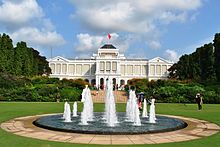

The reserves of the Government of Singapore is a collection of assets, after subtracting for liabilities, owned by the Government of Singapore and the entities listed in the fifth schedule of the Constitution, such as the Central Provident Fund (CPF), Housing and Development Board (HDB) and Temasek Holdings amongst others. This also includes the Official Foreign Reserves (OFR) accumulated by the Monetary Authority of Singapore (MAS) and the assets managed by GIC Private Limited (GIC).[2] Liabilities held by the Government include MAS-issued bonds such as Singapore Government Securities (SGS)[3] and Government-issued Special Singapore Government Securities (SSGS) that are exclusively purchased by CPF with monies from CPF account holders.[4]
Regarding the relationship between the President and Government, the past reserves refers to a portion of the reserves that were not accumulated by the Government during its current term of office. The president's discretion to withhold assent to any transaction proposed by the Government or a fifth schedule entity that is likely to lead to a draw on the past reserves has been referred to as a "second key"[5][6] and is meant to be an independent safeguard against a potential profligate and rogue government wanting to recklessly squander the country's hard-earned reserves.[7][8]
As of 2023, the total size of the reserves has been conservatively estimated to be at least S$2.5 trillion (2024) (US$1.87 trillion), based on publicly available data from GIC,[a] Temasek,[b] MAS,[c] and CPF,[d] among others. It is generally assumed that Singapore's reserves are bigger, far-reaching and significant than publicly acknowledged. However, the Government has consistently maintained that it is not in the national interest of the country to publish the full size of the reserves as doing so "will make it easier for markets to mount speculative attacks on the Singapore dollar during periods of vulnerability."[9]
- ^ "Corrections regarding HDB's deficits and Singapore's Past Reserves". Government of Singapore. Retrieved 31 October 2022.
- ^ "What comprises the reserves and who manages them?". Ministry of Finance. Retrieved 20 October 2022.
- ^ "What comprises our reserves?". Government of Singapore. Retrieved 2 November 2022.
- ^ "Is our CPF money safe? Can the Government pay all its debt obligations?". Ministry of Finance. Retrieved 2 November 2022.
CPF monies are invested by the CPF Board (CPFB) in Special Singapore Government Securities (SSGS) that are issued and guaranteed by the Singapore Government.
- ^ Prime Minister's Office. "Constitutional amendments to safeguard financial assets and the integrity of the public services" (PDF). Retrieved 2 November 2022. p. 7:
The power of the president to grant or withhold his concurrence in these two areas amounts to a two-key safeguard mechanism. The prime minister and Cabinet will possess one key and will take the initiative. For their decision to be valid, the second key must be used; namely, the president must concur.
- ^ Charissa Yong (14 September 2017). "President Halimah Yacob: I will use my independent judgment in exercising my custodial powers". The Straits Times. Retrieved 2 November 2022.
Besides being a symbol of national unity, the president holds the second key to Singapore's hard-earned reserves and significant appointments in the public service
- ^ "Constitution of the Republic of Singapore". Government of Singapore. Retrieved 31 October 2022.
- ^ Tan K. B. Eugene. "Perfecting Singapore's system of political governance: Privileging elites in the quest for good governance". p. 92. Retrieved 31 October 2022.
- ^ "What comprises the reserves and who manages them?". Ministry of Finance. Retrieved 20 October 2022.
MAS and Temasek publish the size of the funds they manage. As of 31 March 2022, the Official Foreign Reserves managed by MAS was S$514 billion and the size of Temasek's net portfolio value was S$403 billion. It is the size of the Government's funds managed by GIC that is not published. What has been revealed is that GIC manages well over US$100 billion. Revealing the exact size of assets that GIC manages will, taken together with the published assets of MAS and Temasek, amount to publishing the full size of Singapore's financial reserves. It is not in our national interest to publish the full size of our reserves. If we do so, it will make it easier for markets to mount speculative attacks on the Singapore dollar during periods of vulnerability. Further, our reserves are a strategic asset, and especially so for a small country with no natural resources or other assets. They are a key defence for Singapore in times of crisis, and it will be unwise to reveal the full and exact resources at our disposal.
Cite error: There are <ref group=lower-alpha> tags or {{efn}} templates on this page, but the references will not show without a {{reflist|group=lower-alpha}} template or {{notelist}} template (see the help page).